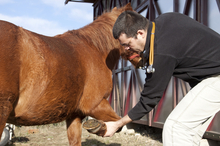According to research by Pulse Veterinary Technologies, many horses can be helped by shock wave therapy. Previously, horses suffering from chronic pain and lameness had to undergo prolonged medication and surgical interventions. These treatments can be costly, necessitate an extended recovery period, and may not provide satisfactory results.

Getting to the bottom of horse lameness
Shock wave treatments for horses with condition related to lameness offer minimally-invasive treatment options that provide enduring results with minimal recovery time.
Now, shock wave treatments offer minimally-invasive treatment options that provide enduring results with minimal recovery time.
The indication for shock wave treatment is made after diagnosis by a veterinarian. Treatment is usually carried out on an out-patient basis in the veterinary practice with the animal in the standing position and mildly sedated.
What are shock waves as used in treatment of horses?
Shock waves are high-energy sound waves which are directed to the affected area. Shock wave treatment works by triggering the body’s own repair mechanisms, helping the body to heal. Shock wave technology therefore provides a long-term improvement. In human medicine, shock wave treatment has been performed for over 20 years to treat a number of urologic and orthopedic conditions in a non-invasive manner.
VersaTron® utilizes electrohydraulic technology to produce shock waves. With this technology, a shock wave is generated at a spark source and is then focused to the target treatment area. The electrohydraulic technology as used in VersaTron® is the only type of shock wave technology that results in shock waves at the focus point for all energy settings.
Shock wave treatment with VersaTron® is recommended for a number of indications including the following:
- Ligaments: insertions and desmitis
- Tendonitis
- Splint bone: fractures and perostitis
- Stress fractures
- Bone spavin
- Navicular syndrome
- Back problems including "kissing spines"
- Joint conditions
How Does the Treatment Occur?
The shock wave treatment typically lasts 10 to 20 minutes depending on the condition. The length of the rest period depends on the underlying injury, and is determined by the veterinarian administering the treatment. A typical treatment regimen may require 2 to 3 treatments spaced two to three weeks apart each.
What Results Can Be Anticipated?
VersaTron provides prompt symptom improvement with results generally seen within one to three weeks following the treatment. VersaTron is the preferred shock wave device of leading equine practitioners and has been proven safe and effective in more equine studies and clinical trials than any other shock wave system.
